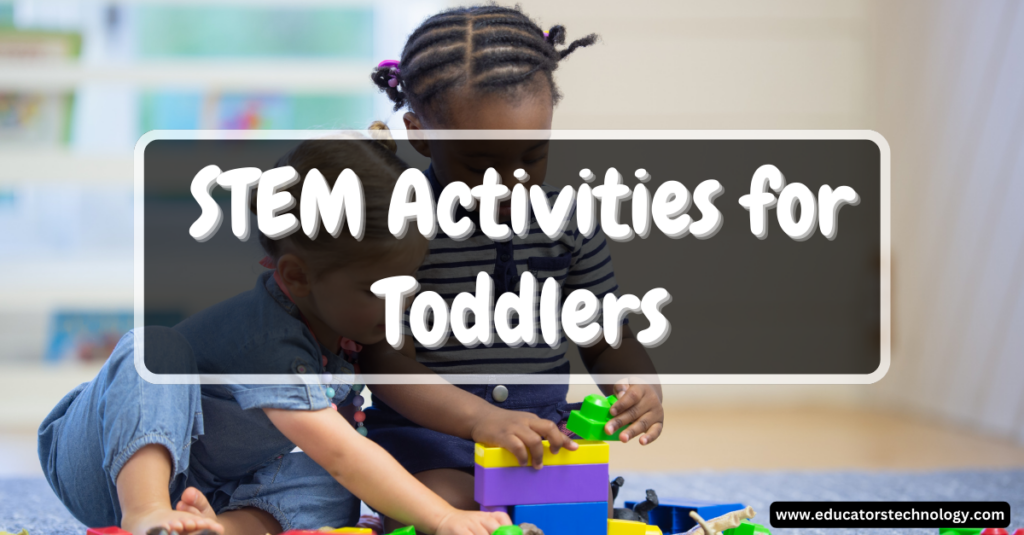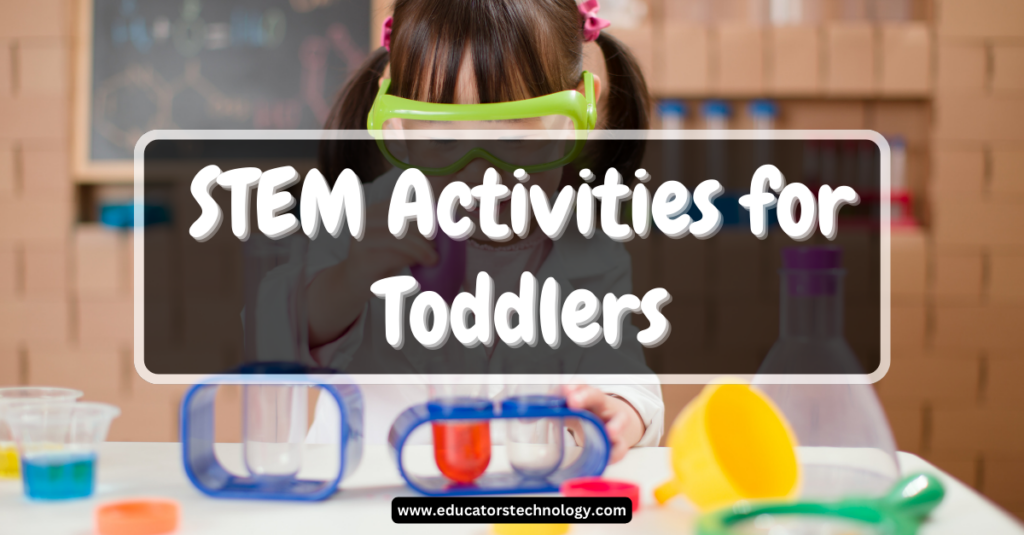TechGuruindia
Member
From my earliest days in the classroom to my most recent endeavors as an educator, I’ve always held a deep belief in the power of hands-on learning. Nothing quite compares to the spark in a child’s eyes when they make a discovery, when a concept clicks, or when they realize they’ve created something entirely on their own.

These moments of understanding, of connection, are what education is all about. They are the milestones that mark not just academic growth, but also the development of a lifelong love of learning.
The importance of these experiences is particularly evident when working with our youngest learners—toddlers. With their boundless energy, insatiable curiosity, and unfiltered enthusiasm, toddlers are little scientists, engineers, and mathematicians in their own right.
They learn by exploring, by experimenting, by pushing the boundaries of their world in a constant quest to understand more. And this is exactly where —Science, Technology, Engineering, and Math—comes into play.
STEM is not just about instilling technical skills—it’s about fostering curiosity, encouraging exploration, and teaching children to think creatively and critically. It’s about showing them that the world is a fascinating place, full of mysteries to solve, puzzles to piece together, and wonders to marvel at.
And the best part? You don’t need a lab or expensive equipment to teach STEM. In fact, some of the most impactful STEM activities are those that use everyday objects and settings to demonstrate these crucial concepts.
So, whether you’re a parent looking for fun ways to keep your toddler engaged, or an educator seeking to introduce STEM in your classroom, the activities I’ve compiled here are designed with one goal in mind: to ignite that spark of curiosity in our toddlers and fuel their journey of discovery.
[Related: ]
STEM (Science, Technology, Engineering, and Mathematics) education plays a crucial role in preparing children for a future that is becoming increasingly dependent on these fields. Here are some why STEM activities are essential for children:
Indeed, integrating STEM activities into children’s learning journey is not just about preparing them for STEM-related careers; it’s about equipping them with a set of skills and mindsets that will benefit them no matter what path they choose in life. It’s about nurturing curious, creative, and capable learners who are ready to explore and shape the world around them.

Here are some practical suggestions for helpful STEM activities for toddlers (you can also check these best ):
As I stated earlier, the key to these activities is to keep them fun and engaging. Encourage your toddler’s natural curiosity and make sure to ask lots of questions to promote their thinking and understanding.
The post appeared first on .

These moments of understanding, of connection, are what education is all about. They are the milestones that mark not just academic growth, but also the development of a lifelong love of learning.
The importance of these experiences is particularly evident when working with our youngest learners—toddlers. With their boundless energy, insatiable curiosity, and unfiltered enthusiasm, toddlers are little scientists, engineers, and mathematicians in their own right.
They learn by exploring, by experimenting, by pushing the boundaries of their world in a constant quest to understand more. And this is exactly where —Science, Technology, Engineering, and Math—comes into play.
STEM is not just about instilling technical skills—it’s about fostering curiosity, encouraging exploration, and teaching children to think creatively and critically. It’s about showing them that the world is a fascinating place, full of mysteries to solve, puzzles to piece together, and wonders to marvel at.
And the best part? You don’t need a lab or expensive equipment to teach STEM. In fact, some of the most impactful STEM activities are those that use everyday objects and settings to demonstrate these crucial concepts.
So, whether you’re a parent looking for fun ways to keep your toddler engaged, or an educator seeking to introduce STEM in your classroom, the activities I’ve compiled here are designed with one goal in mind: to ignite that spark of curiosity in our toddlers and fuel their journey of discovery.
[Related: ]
Benefits of STEM Education
STEM (Science, Technology, Engineering, and Mathematics) education plays a crucial role in preparing children for a future that is becoming increasingly dependent on these fields. Here are some why STEM activities are essential for children:
- Develops Problem-Solving Skills: STEM activities often involve real-world problems that require creative and analytical thinking to solve. These activities encourage children to use their critical thinking skills, fostering their ability to problem-solve and make informed decisions.
- Encourages Creativity and Innovation: STEM learning is not just about consuming knowledge; it’s about creating and innovating. Through hands-on activities, children can design solutions, build structures, and experiment with different strategies, which nurtures their creativity and innovation.
- Prepares for Future Careers: Many of the fastest-growing occupations in the next decade are expected to be in STEM fields. By introducing children to STEM concepts early, we are setting them up for success in a world where these skills will be highly sought after.
- Promotes Lifelong Learning: STEM activities encourage a love for learning by making the learning process engaging and fun. These activities often involve exploration and discovery, which fosters curiosity and the desire to continue learning.
- Teaches Teamwork: Many STEM activities require collaboration, which helps children develop communication and teamwork skills. By working together, children learn to listen to others’ ideas, express their own thoughts, and contribute to a shared goal.
- Integrates Knowledge Across Disciplines: STEM learning is interdisciplinary by nature. It bridges the gap between different subjects and helps children understand how they can apply knowledge from one area (like mathematics) to solve problems in another area (like engineering).
- Enhances Resilience: STEM activities often involve trial and error. By facing and overcoming challenges, children learn to be resilient and understand that it’s okay to make mistakes – what’s important is learning from them.
- Promotes Digital Literacy: Technology plays a significant role in STEM. By engaging with technology from a young age, children develop digital literacy, which is vital in today’s digitally-driven world.
Indeed, integrating STEM activities into children’s learning journey is not just about preparing them for STEM-related careers; it’s about equipping them with a set of skills and mindsets that will benefit them no matter what path they choose in life. It’s about nurturing curious, creative, and capable learners who are ready to explore and shape the world around them.

STEM Activities for Toddlers
Here are some practical suggestions for helpful STEM activities for toddlers (you can also check these best ):
- Shape Sorting: Use a shape sorting toy to introduce your toddler to different shapes and encourage their problem-solving skills.
- Stacking Blocks: Build towers with blocks and discuss size and balance.
- Color Mixing: Use food coloring or paint to teach your toddler about primary and secondary colors.
- Nature Exploration: Go on a nature walk and talk about the different plants and animals you see.
- Bubble Play: Blow bubbles and observe their shape and the colors reflected in them.
- Bath Time Floating/Sinking: Use bath toys to discuss why some items float while others sink.
- Sensory Bins: Create sensory bins with different materials like sand, water beads, or pasta to explore textures.
- Animal Sounds: Teach your toddler about different animals and the sounds they make.
- Exploring Magnets: Use a magnet to show your toddler what items are magnetic.
- Counting Games: Use toys or snacks to practice counting.
- Ice Melting: Freeze small toys in ice and let your toddler melt the ice to retrieve them.
- Shadow Play: Use a flashlight to create shadows and explain how they’re made.
- Making Music: Use pots, pans, and spoons to explore different sounds and rhythms.
- Finger Painting: Introduce your toddler to the concept of color mixing through finger painting.
- Puzzles: Simple puzzles can help improve your toddler’s problem-solving skills and spatial reasoning.
- Planting Seeds: Let your toddler help you plant seeds and watch them grow.
- Water Play: Use a water table or simply a bowl of water to explore concepts like volume and displacement.
- Sorting Games: Sort toys or snacks by color or size.
- Ramp Play: Create a simple ramp with cardboard and explore how different objects roll down.
- Weather Observation: Observe and discuss the weather each day to introduce basic concepts about climate and weather patterns.
As I stated earlier, the key to these activities is to keep them fun and engaging. Encourage your toddler’s natural curiosity and make sure to ask lots of questions to promote their thinking and understanding.
The post appeared first on .
